Abstract
OBJECTIVES: The role of lead exposure as a risk factor for hypertension is less well defined among women than among men. This case-control study assessed the relation of blood and bone lead concentrations to hypertension in women. METHODS: Cases and controls were a subsample of women from the Nurses' Health Study. Hypertension was defined as a physician diagnosis of hypertension between 1988 and 1994 or measured systolic blood pressure > or = 140 mm Hg or diastolic blood pressure > or = 90 mm Hg. RESULTS: Mean (SD) blood lead concentration was 0.15 (0.11) mumol/L; mean tibia and patella lead concentrations by K-x-ray fluorescence were 13.3 (9.0) and 17.3 (11.1) micrograms/g, respectively. After adjustment for potentially confounding factors, an increase from the 10th to the 90th percentile of patella lead values (25 micrograms/g) was associated with approximately 2-fold (95% confidence interval = 1.1, 3.2) increased risk of hypertension. There was no association between hypertension and either blood or tibia lead concentrations. CONCLUSIONS: These findings support a potentially important role for low-level lead exposure as a risk factor for hypertension among non-occupationally exposed women.
Full text
PDF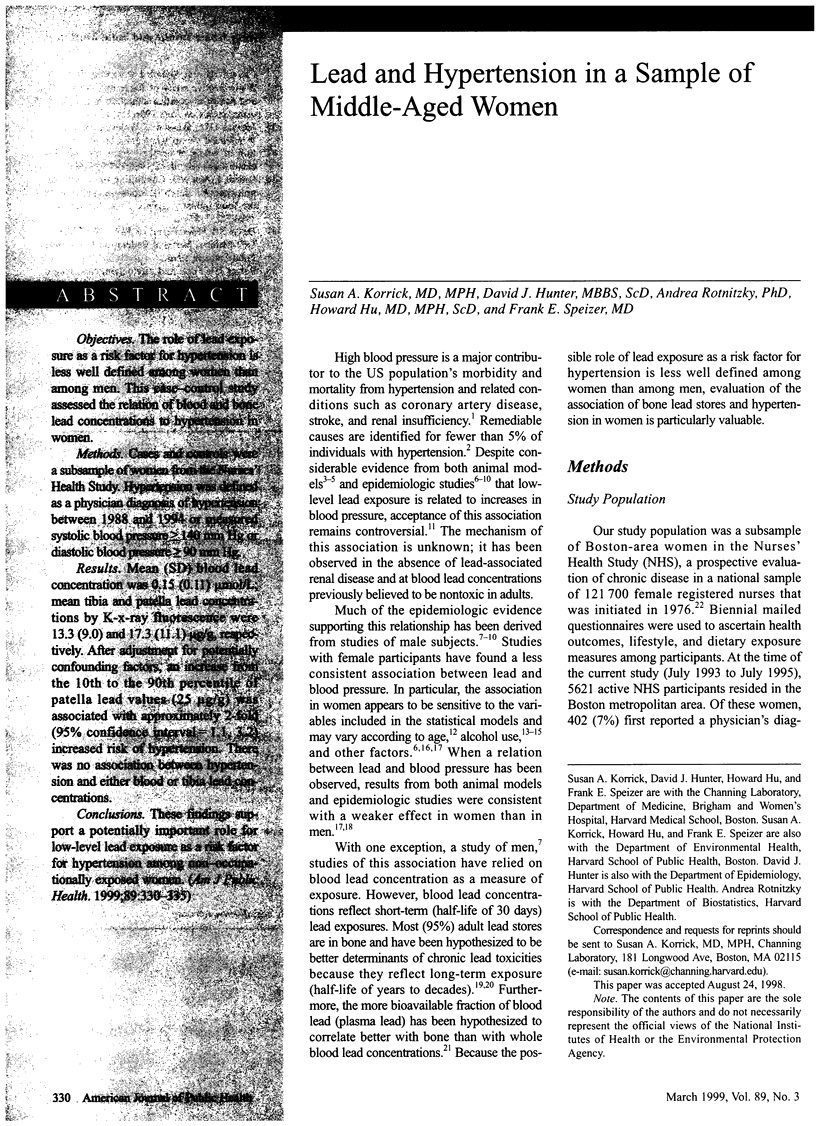
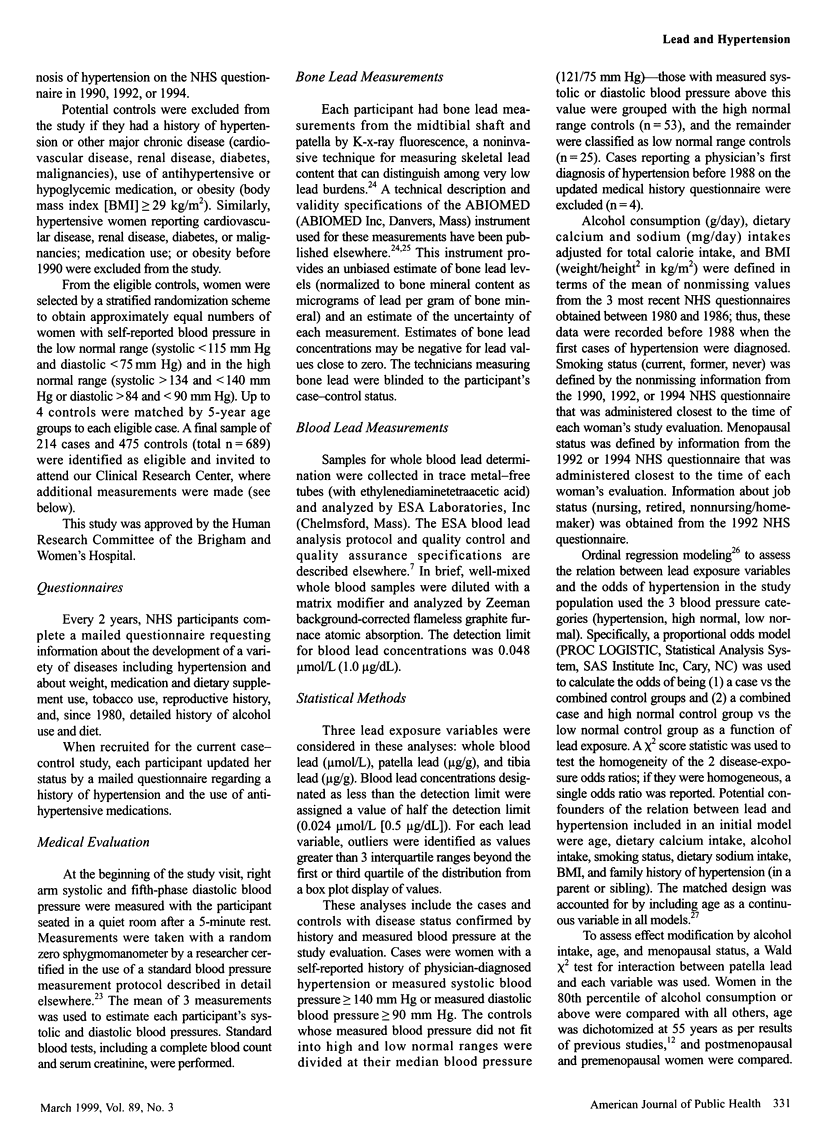
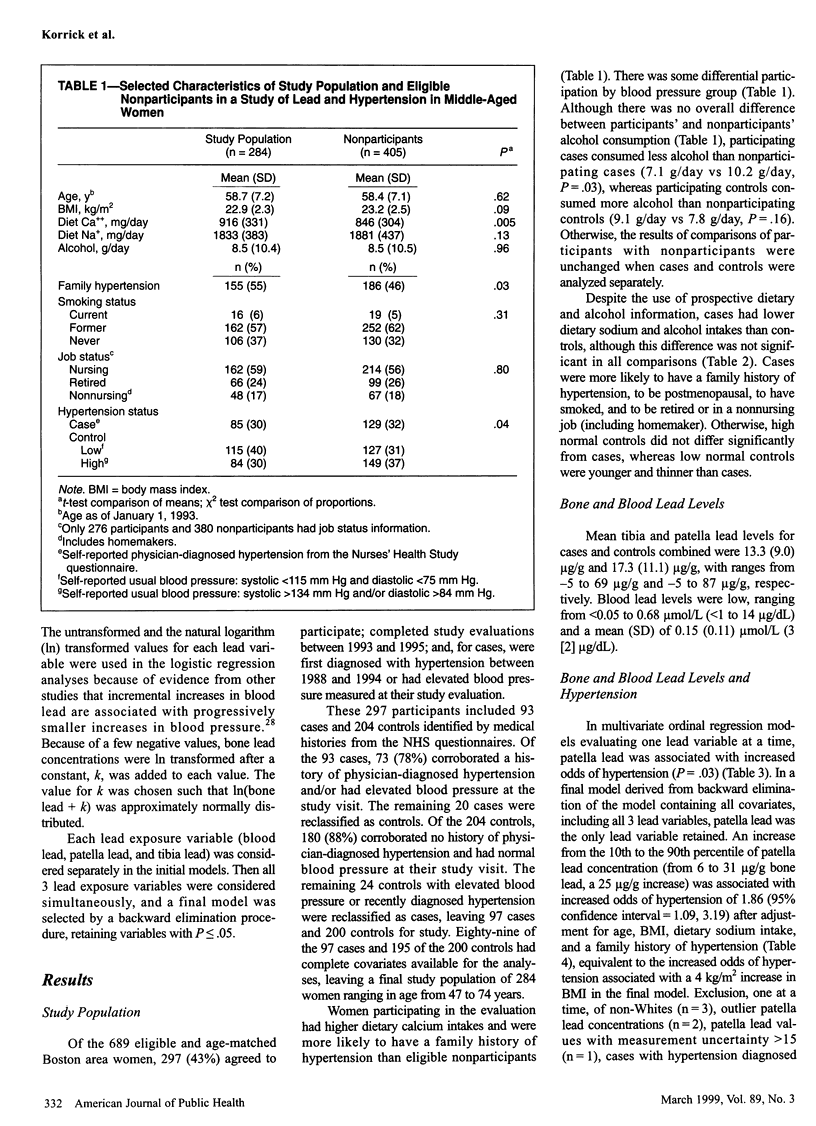
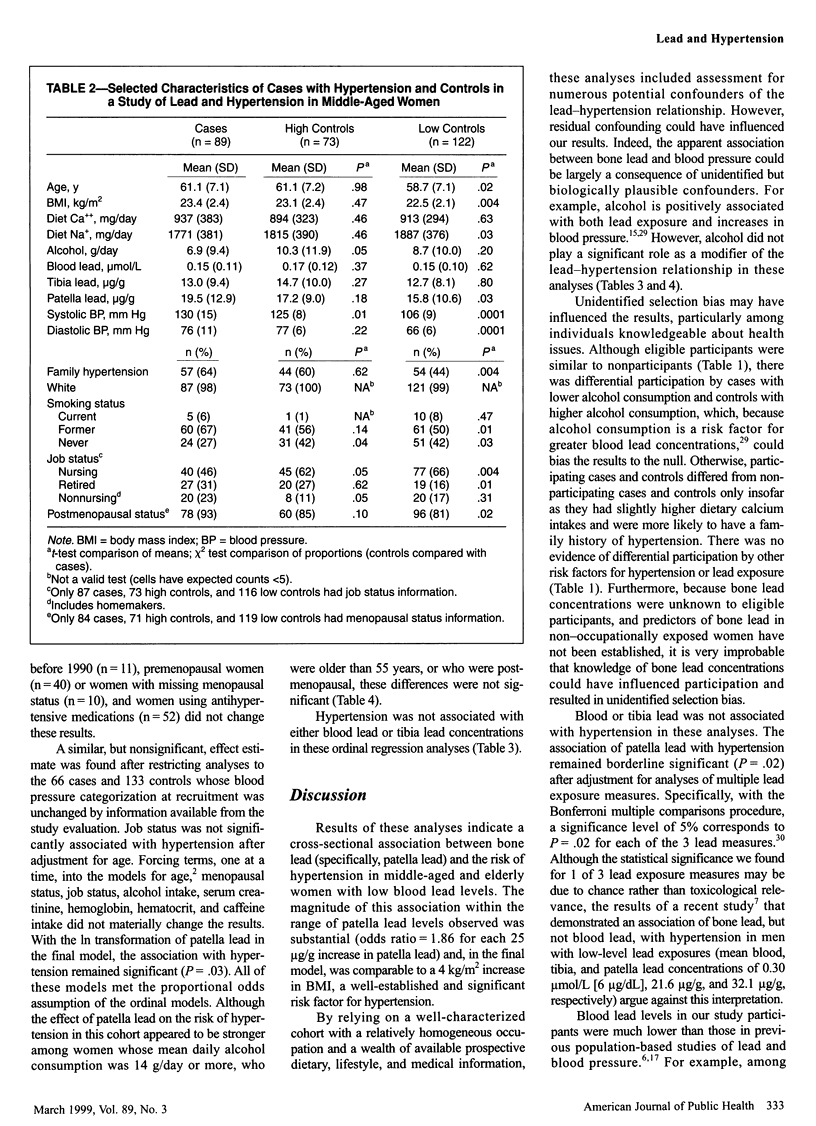
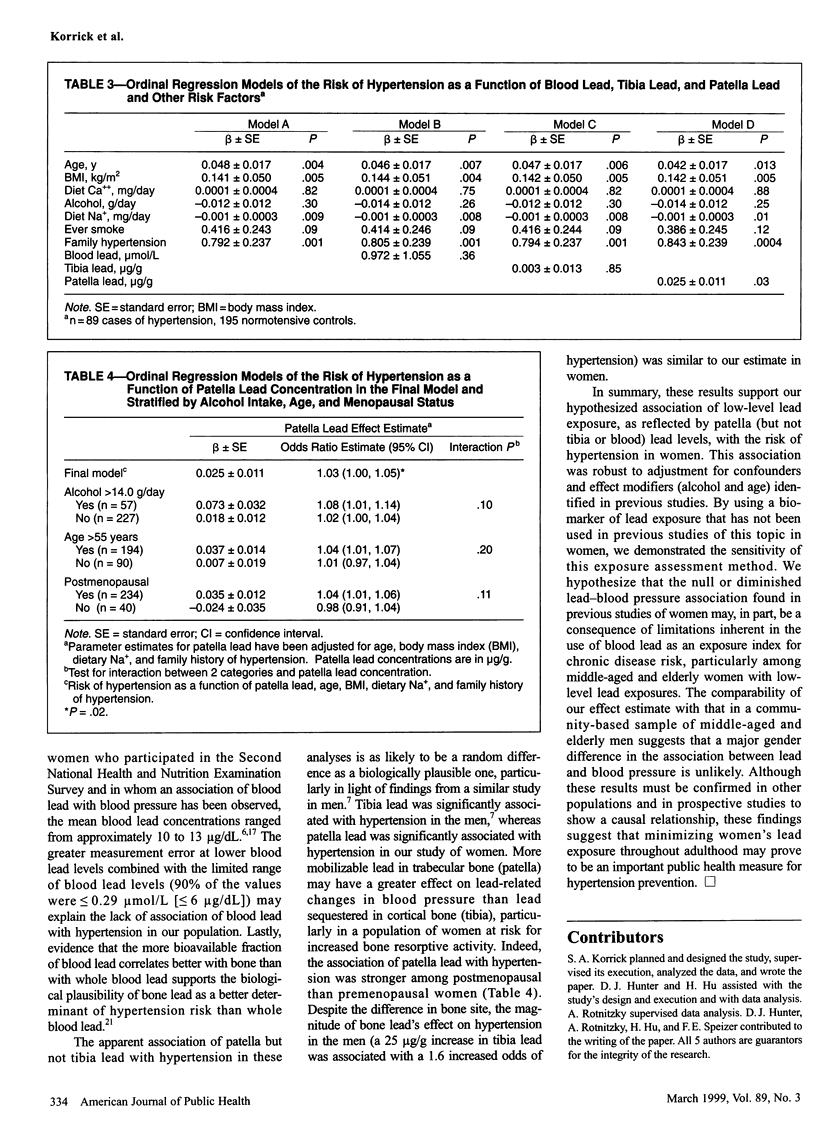
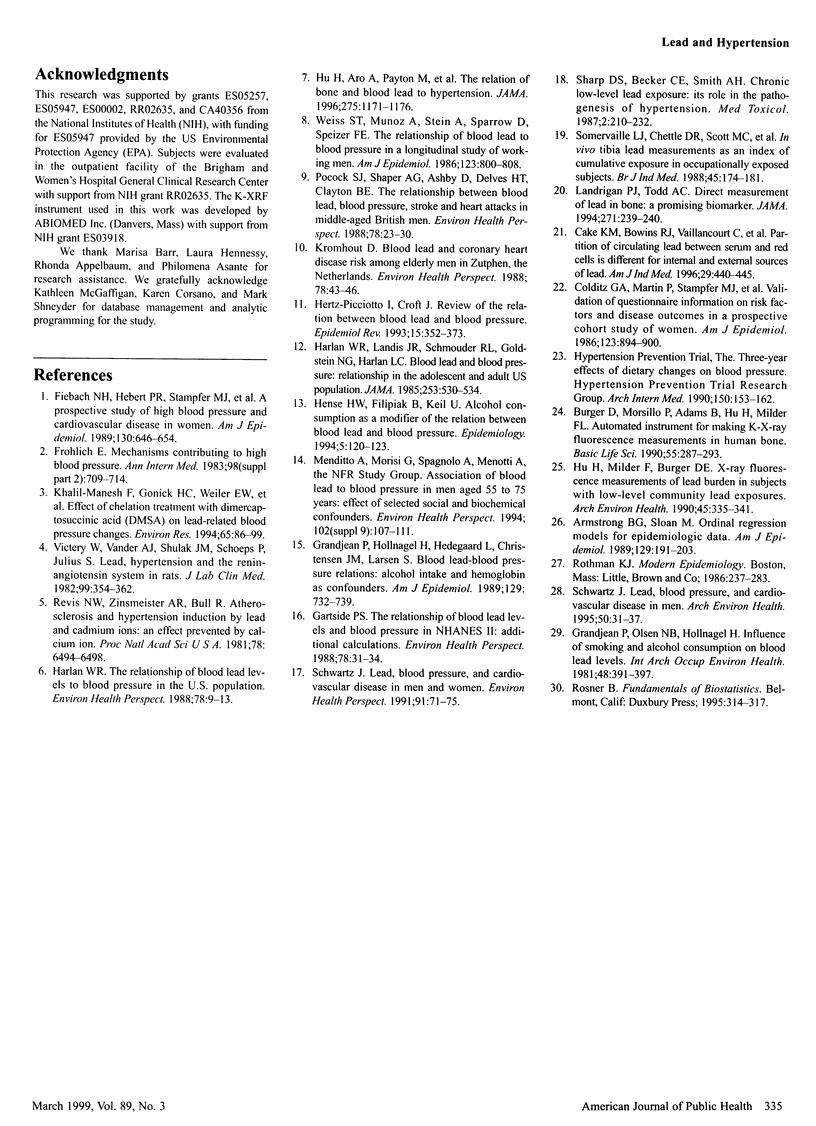
Selected References
These references are in PubMed. This may not be the complete list of references from this article.
- Armstrong B. G., Sloan M. Ordinal regression models for epidemiologic data. Am J Epidemiol. 1989 Jan;129(1):191–204. doi: 10.1093/oxfordjournals.aje.a115109. [DOI] [PubMed] [Google Scholar]
- Burger D. E., Milder F. L., Morsillo P. R., Adams B. B., Hu H. Automated bone lead analysis by K-x-ray fluorescence for the clinical environment. Basic Life Sci. 1990;55:287–292. doi: 10.1007/978-1-4613-1473-8_39. [DOI] [PubMed] [Google Scholar]
- Cake K. M., Bowins R. J., Vaillancourt C., Gordon C. L., McNutt R. H., Laporte R., Webber C. E., Chettle D. R. Partition of circulating lead between serum and red cells is different for internal and external sources of lead. Am J Ind Med. 1996 May;29(5):440–445. doi: 10.1002/(SICI)1097-0274(199605)29:5<440::AID-AJIM2>3.0.CO;2-Q. [DOI] [PubMed] [Google Scholar]
- Colditz G. A., Martin P., Stampfer M. J., Willett W. C., Sampson L., Rosner B., Hennekens C. H., Speizer F. E. Validation of questionnaire information on risk factors and disease outcomes in a prospective cohort study of women. Am J Epidemiol. 1986 May;123(5):894–900. doi: 10.1093/oxfordjournals.aje.a114319. [DOI] [PubMed] [Google Scholar]
- Fiebach N. H., Hebert P. R., Stampfer M. J., Colditz G. A., Willett W. C., Rosner B., Speizer F. E., Hennekens C. H. A prospective study of high blood pressure and cardiovascular disease in women. Am J Epidemiol. 1989 Oct;130(4):646–654. doi: 10.1093/oxfordjournals.aje.a115386. [DOI] [PubMed] [Google Scholar]
- Frohlich E. D. Mechanisms contributing to high blood pressure. Ann Intern Med. 1983 May;98(5 Pt 2):709–714. doi: 10.7326/0003-4819-98-5-709. [DOI] [PubMed] [Google Scholar]
- Gartside P. S. The relationship of blood lead levels and blood pressure in NHANES II: additional calculations. Environ Health Perspect. 1988 Jun;78:31–34. doi: 10.1289/ehp.887831. [DOI] [PMC free article] [PubMed] [Google Scholar]
- Grandjean P., Hollnagel H., Hedegaard L., Christensen J. M., Larsen S. Blood lead-blood pressure relations: alcohol intake and hemoglobin as confounders. Am J Epidemiol. 1989 Apr;129(4):732–739. doi: 10.1093/oxfordjournals.aje.a115188. [DOI] [PubMed] [Google Scholar]
- Grandjean P., Olsen N. B., Hollnagel H. Influence of smoking and alcohol consumption on blood lead levels. Int Arch Occup Environ Health. 1981;48(4):391–397. doi: 10.1007/BF00378687. [DOI] [PubMed] [Google Scholar]
- Harlan W. R., Landis J. R., Schmouder R. L., Goldstein N. G., Harlan L. C. Blood lead and blood pressure. Relationship in the adolescent and adult US population. JAMA. 1985 Jan 25;253(4):530–534. doi: 10.1001/jama.253.4.530. [DOI] [PubMed] [Google Scholar]
- Harlan W. R. The relationship of blood lead levels to blood pressure in the U.S. population. Environ Health Perspect. 1988 Jun;78:9–13. doi: 10.1289/ehp.88789. [DOI] [PMC free article] [PubMed] [Google Scholar]
- Hense H. W., Filipiak B., Keil U. Alcohol consumption as a modifier of the relation between blood lead and blood pressure. Epidemiology. 1994 Jan;5(1):120–123. doi: 10.1097/00001648-199401000-00018. [DOI] [PubMed] [Google Scholar]
- Hertz-Picciotto I., Croft J. Review of the relation between blood lead and blood pressure. Epidemiol Rev. 1993;15(2):352–373. doi: 10.1093/oxfordjournals.epirev.a036125. [DOI] [PubMed] [Google Scholar]
- Hu H., Aro A., Payton M., Korrick S., Sparrow D., Weiss S. T., Rotnitzky A. The relationship of bone and blood lead to hypertension. The Normative Aging Study. JAMA. 1996 Apr 17;275(15):1171–1176. [PubMed] [Google Scholar]
- Hu H., Milder F. L., Burger D. E. X-ray fluorescence measurements of lead burden in subjects with low-level community lead exposure. Arch Environ Health. 1990 Nov-Dec;45(6):335–341. doi: 10.1080/00039896.1990.10118752. [DOI] [PubMed] [Google Scholar]
- Khalil-Manesh F., Gonick H. C., Weiler E. W., Prins B., Weber M. A., Purdy R., Ren Q. Effect of chelation treatment with dimercaptosuccinic acid (DMSA) on lead-related blood pressure changes. Environ Res. 1994 Apr;65(1):86–99. doi: 10.1006/enrs.1994.1023. [DOI] [PubMed] [Google Scholar]
- Kromhout D. Blood lead and coronary heart disease risk among elderly men in Zutphen, The Netherlands. Environ Health Perspect. 1988 Jun;78:43–46. doi: 10.1289/ehp.887843. [DOI] [PMC free article] [PubMed] [Google Scholar]
- Landrigan P. J., Todd A. C. Direct measurement of lead in bone. A promising biomarker. JAMA. 1994 Jan 19;271(3):239–240. [PubMed] [Google Scholar]
- Menditto A., Morisi G., Spagnolo A., Menotti A. Association of blood lead to blood pressure in men aged 55 to 75 years: effect of selected social and biochemical confounders. NFR Study Group. Environ Health Perspect. 1994 Nov;102 (Suppl 9):107–111. doi: 10.1289/ehp.94102s9107. [DOI] [PMC free article] [PubMed] [Google Scholar]
- Pocock S. J., Shaper A. G., Ashby D., Delves H. T., Clayton B. E. The relationship between blood lead, blood pressure, stroke, and heart attacks in middle-aged British men. Environ Health Perspect. 1988 Jun;78:23–30. doi: 10.1289/ehp.887823. [DOI] [PMC free article] [PubMed] [Google Scholar]
- Schwartz J. Lead, blood pressure, and cardiovascular disease in men and women. Environ Health Perspect. 1991 Feb;91:71–75. doi: 10.1289/ehp.919171. [DOI] [PMC free article] [PubMed] [Google Scholar]
- Schwartz J. Lead, blood pressure, and cardiovascular disease in men. Arch Environ Health. 1995 Jan-Feb;50(1):31–37. doi: 10.1080/00039896.1995.9955010. [DOI] [PubMed] [Google Scholar]
- Sharp D. S., Becker C. E., Smith A. H. Chronic low-level lead exposure. Its role in the pathogenesis of hypertension. Med Toxicol. 1987 May-Jun;2(3):210–232. doi: 10.1007/BF03259865. [DOI] [PubMed] [Google Scholar]
- Somervaille L. J., Chettle D. R., Scott M. C., Tennant D. R., McKiernan M. J., Skilbeck A., Trethowan W. N. In vivo tibia lead measurements as an index of cumulative exposure in occupationally exposed subjects. Br J Ind Med. 1988 Mar;45(3):174–181. doi: 10.1136/oem.45.3.174. [DOI] [PMC free article] [PubMed] [Google Scholar]
- Victery W., Vander A. J., Shulak J. M., Schoeps P., Julius S. Lead, hypertension, and the renin-angiotensin system in rats. J Lab Clin Med. 1982 Mar;99(3):354–362. [PubMed] [Google Scholar]
- Weiss S. T., Muñoz A., Stein A., Sparrow D., Speizer F. E. The relationship of blood lead to blood pressure in a longitudinal study of working men. Am J Epidemiol. 1986 May;123(5):800–808. doi: 10.1093/oxfordjournals.aje.a114309. [DOI] [PubMed] [Google Scholar]


